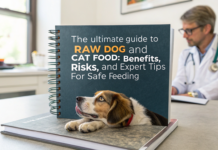Last Updated on April 18, 2023 by Dogs Vets
How Whole Foods Makes the Best Kidney Dog Food
Has your dog been diagnosed with chronic or acute kidney disease? Are you trying to determine how to provide your dog with a longer, healthier life?
If you’ve answered “yes” to both questions, you should look into swapping your dog’s current food for kidney dog food. More specifically, it’s time to consider whole food ingredients instead of kibble for their meals.
Keep reading to learn why kibble can cause harm for dogs with kidney disease, and how whole foods can drastically improve their health.
Why Whole Foods Are Better than Kibble
No matter how expensive, organic, or premium a brand’s kibble claims to be, it will never be as good as whole food ingredients. How kibble is made takes away all of the important vitamins and nutrients dogs need—especially those dealing with chronic kidney disease (CKD).
How Kibble Is Made
Kibble is a dog’s version of junk food. It has many preservatives and chemicals for extended shelf life. Furthermore, it doesn’t stay fresh once you open the bag. In fact, kibble can collect different bacteria and, in extreme cases, even fungi.
What kibble is made of—and how it’s made—makes it unhealthy for dogs.
Kibble is made up of animal by-products (meaning the leftover parts of animals humans don’t eat). Leftover parts are dried for easier separation from fat and moisture, then cooked and ground up to create a meal mixture.
Sometimes other ingredients, such as veggies and grains, are added, but they are typically heavily processed and devoid of real nutrients (and taste).
Everything is then mixed to create a dough that’s cooked at extremely high temperatures. This process, known scientifically as extrusion, destroys most remaining vitamins, enzymes, and minerals. It also takes out all moisture (a major no-no for CKD).
Once cooked, kibble is then sprayed with rendered fats for taste, and synthetic nutrients are added to make up for what was lost. These synthetic nutrients don’t break down in the body the same way as the real thing, meaning your dog isn’t getting enough.
Health Benefits of Whole Foods for Dogs
Needless to say, kibble isn’t good for your dog. But are whole food ingredients that much better?
Yes.
There are many health benefits to switching to a whole food diet, and some specifically for dogs with CKD.
Here’s a list of health benefits for dogs that come with whole foods:
- Easier digestion: Dogs have an easier time digesting whole food because there aren’t unnecessary perseveres and chemicals. Easy digestion is crucial for dogs with kidney disease—it allows the body to direct more energy toward proper kidney function.
- Better pooping: A nice side effect of better digestion is your dog will have an easier time going to the bathroom—and their poop won’t smell as bad!
- Better skin and coat health: Because dogs get access to original sources of nutrients like zinc, B vitamins, and omega-3 fatty acids, they’ll have healthier skin and coats.
- Easier weight control: Obesity is a common problem with dogs, and much of that can be attributed to processed food like kibble. They’re filled with too much starch and other empty calories. Weight is important for dogs with CKD, as excess weight puts more strain on the kidneys.
- Increased energy: Processed food takes more energy to digest, which is where much of a dog’s energy goes. With whole foods, dogs have more energy to play and more energy to put towards helping their kidneys.
- Better immune system: Unfiltered access to nutrients like vitamins A and C, zinc, antioxidants, enzymes, and amino acids keeps the immune system healthy and stronger. Dogs with CKD can develop a weakened immune system due to the kidney’s decline, so a better immune system keeps them safe from getting sick from other illnesses.
What Whole Food Ingredients to Look For in Kidney Food for Dogs
Here’s what you should look for when reviewing ingredients in kidney dog food:
Calcium
Getting more sources of calcium is crucial to a dog’s kidney diet.
Calcium is a natural phosphorus binder, so having more calcium in your dog’s diet means less phosphorus will affect the kidneys. Even something as small as adding crushed eggshells to a meal will improve your dog’s kidneys.
You can also feed them yogurt or some cheese as a healthy treat.
Fruits and Veggies
Dogs love the taste of fruits and veggies; they’re an excellent source of essential vitamins and minerals that keep your dog’s body running smoothly.
Fruits and vegetables that are great for chronic kidney disease are:
● Apples
● Asparagus
● Bananas
● Beets
● Bell peppers
● Broccoli
● Cabbage
● Carrots
● Celery
● Cranberries
● Green beans
● Mango
● Peach
● Pear
● Peas
● Pumpkin
● Squash
High-Quality Protein
Some commercial kidney dog foods have little to no protein in their recipes. This is because kidneys filter protein—and therefore struggle to do so when kidneys struggle. Without protein, however, your dog’s muscles will start to weaken.
Instead of completely cutting protein from your dog’s diet, you must focus on high-quality protein. This way, you won’t need to feed your dog as much protein while maintaining muscle mass.
Use more egg whites, beef, pork, and lamb.
Lots of Water
Staying hydrated is absolutely crucial for dogs dealing with CKD. Being properly hydrated makes the kidneys’ job far easier, which eases symptoms. Juicy fruits and vegetables like celery, cranberries, and cabbage are great (and tasty) sources of hydration.
Omega-3s
Inflammation creates oxidative stress on the kidneys, which weakens them further. Omega-3 fatty acids are excellent anti-inflammatories and crucial for dogs with kidney disease. They can even slow down the progression of kidney disease.
Including more sources of omega-3—like flaxseed, fish oil, salmon, and even some fruits and veggies—will naturally alleviate symptoms of kidney disease.
Potassium
It’s common for dogs with chronic kidney disease to have lower amounts of potassium, which causes muscle loss and weakness.
When looking for kidney food for dogs, you should take care to include sources of potassium.
Foods with high potassium levels are:
- Apples
- Avocados
- Bananas
- Potatoes (sweet and white)
- Salmon
- Spinach
- Squash
What Foods to Avoid When a Dog Has Kidney Disease
Some whole food ingredients can worsen your dog’s kidney problems. Here’s what you need to avoid when looking at kidney diet dog food:
High Sodium Sources
Salt in a kidney dog diet is a tricky balance. You shouldn’t completely get rid of it, but a high amount of sodium will put a strain on the kidneys and lead to hypertension and dehydration.
Sources of higher sodium are red meat, chicken, eggs, and seafood. It’s important to still use red meat and eggs in your dog’s diet, so use other foods like fruits and veggies to better balance sodium levels within your dog’s body.
High Phosphorus Sources
Phosphorus is filtered through the kidneys, and when the kidneys start to decline, phosphorus can build up and cause more stress to the kidneys.
Additionally, excess phosphorus can quickly become toxic and make your dog feel worse.
While you shouldn’t completely cut out this mineral, you should avoid sources of a high amount of phosphorus, including:
● Bones
● Brown rice
● Chicken
● Dairy products
● Egg yolks
● Oatmeal
● Organ meats
● Whole wheat
Other Foods to Avoid
When creating a kidney-friendly diet for your dog avoid these foods too:
- Chocolate
- Citrus
- Coconuts
- Garlic
- Grapes
- Macadamia nuts
- Nutmeg
- Onion
- Processed dog treats
- Raisins
Switch to Whole Food Ingredients for Your Dog’s Kidney Food
It’s time to retire kibble and focus on feeding your dog whole food ingredients. Not only will whole food ingredients make your dog feel healthier, but they’ll also ease the symptoms that come with having chronic kidney disease.
Some pet parents hesitate to use a whole food diet due to the amount of prep work that’s required—but that’s not always the case.
There are plenty of options that offer the convenience of kibble while providing the same nutritional value as home-cooked meals.
You’ll be amazed at how much better your dog will feel after the switch.
Fact Check
We hope you enjoyed reading this article. What are your thoughts on the topic?
“At [Dogsvets.com], our goal is to bring you the most accurate and up-to-date information on all things pet-related.
If you have any additional insights or would like to advertise with us, don’t hesitate to get in touch.
If you notice any errors or discrepancies in our content, please let us know so we can correct them.
We welcome your feedback and encourage you to share this article with others.”

















